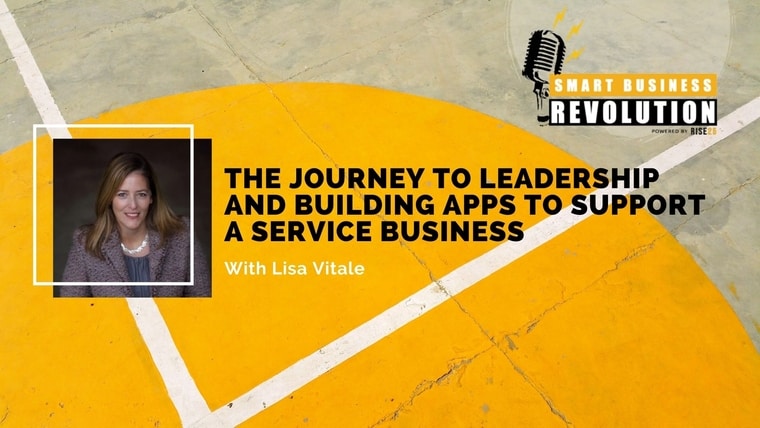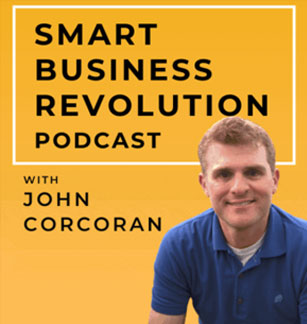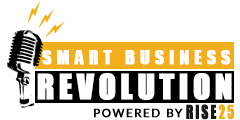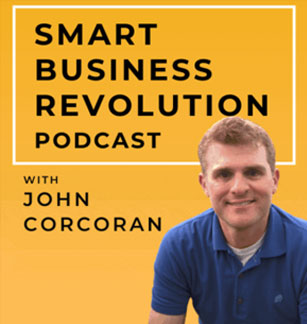

Lisa Vitale is the President of SimplyDIRECT and of Entrepreneurs’ Organization (EO) Boston chapter. She has more than 20 years of experience in marketing strategy at SimplyDIRECT, focusing on delivering client campaigns on schedule and on spec. Lisa started at SimplyDIRECT as CFO and previously worked for the Boston Museum of Fine Arts and PJA Advertising + Marketing. She has been a member of EO Boston since 2013 and will remain the President-Elect until June 2023.
In this episode of the Smart Business Revolution Podcast, John Corcoran is joined by Lisa Vitale, the President of SimplyDIRECT and Entrepreneurs’ Organization (EO) Boston, to talk about Lisa’s journey in developing a customized app for her business. Lisa talks about the challenges she faced upgrading her app, what she learned from her mentors, and how she guides her team in handling business problems. Stay tuned.
Here’s a Glimpse of What You’ll Hear:
- Lisa Vitale talks about developing an app for her business and the challenges she faced upgrading it
- What Lisa evaluated before creating a customized app
- Lisa’s advice on using in-house talent versus hiring an outside agency to develop an app
- What Lisa does to guide her team in resolving issues with clients
- What Lisa learned about herself while in the process of buying out her former business partner
- The mentors Lisa has had and how she mentors others
- What excites Lisa about the future, the peers she respects, and where to learn more about her
Resources Mentioned In This Episode
- Lisa Vitale on LinkedIn
- SimplyDIRECT
- SimplyDIRECT on Twitter
- SimplyDIRECT on Facebook
- Wendy Pease on LinkedIn
- Rapport International
- Entrepreneurs’ Organization (EO)
- Bill Flynn on LinkedIn
- Catalyst Growth Advisors
Sponsor: Rise25
At Rise25, we’re committed to helping you connect with your Dream 100 referral partners, clients, and strategic partners through our done-for-you podcast solution.
We’re a professional podcast production agency that makes creating a podcast effortless. Since 2009, our proven system has helped thousands of B2B businesses build strong relationships with referral partners, clients, and audiences without doing the hard work.
What do you need to start a podcast?
When you use our proven system, all you need is an idea and a voice. We handle the strategy, production, and distribution – you just need to show up and talk.
The Rise25 podcasting solution is designed to help you build a profitable podcast. This requires a specific strategy, and we’ve got that down pat. We focus on making sure you have a direct path to ROI, which is the most important component. Plus, our podcast production company takes any heavy lifting of production and distribution off your plate.
We make distribution easy
We’ll distribute each episode across more than 11 unique channels, including iTunes, Spotify, and Google Podcasts. We’ll also create copy for each episode and promote your show across social media.
Cofounders Dr. Jeremy Weisz and John Corcoran credit podcasting as being the best thing they have ever done for their businesses. Podcasting connected them with the founders/CEOs of P90x, Atari, Einstein Bagels, Mattel, Rx Bars, YPO, EO, Lending Tree, Freshdesk, and many more.
The relationships you form through podcasting run deep. Jeremy and John became business partners through podcasting. They have even gone on family vacations and attended weddings of guests who have been on the podcast.
Podcast production has a lot of moving parts and is a big commitment on our end; we only want to work with people who are committed to their business and to cultivating amazing relationships.
Are you considering launching a podcast to acquire partnerships, clients, and referrals? Would you like to work with a podcast agency that wants you to win?
Contact us now at [email protected] or book a call at rise25.com/bookcall.
Rise25 Cofounders, Dr. Jeremy Weisz and John Corcoran, have been podcasting and advising about podcasting since 2008.
Episode Transcript
Intro 0:10
Welcome to the revolution, the Smart Business Revolution Podcast, where we ask today’s most successful entrepreneurs to share the tools and strategies they use to build relationships and connections to grow their revenue. Now, your host for the revolution, John Corcoran.
John Corcoran 0:40
All right, welcome everyone. John Corcoran here. I’m the host of this show and new every week I get to talk to smart CEOs, founders and entrepreneurs all kinds of companies go check out the archives of some great episodes there with founders or CEOs of Netflix and Kinkos’ YPO, EO, Activision Blizzard, LendingTree, OpenTable and many more. I’m also the Co-founder of Rise25, where we help connect b2b business owners with their ideal prospects. And a quick shout out and thank you to Wendy Pease of Rapport International, who introduced me to today’s guest, whose name is Lisa Vitale. She is President and brings more than 20 years of marketing strategy experience at SimplyDIRECT, focusing on delivering client campaigns on schedule and on spec. She started at SimplyDIRECT as CFO, previously worked for the Boston Museum of Fine Arts and Philip Johnson Associates and is the founder of the Sudbury de festival. She has been a member of EO Boston for Entrepreneurs Organization since 2013. And has most recently been named EO Boston Chapter President Elect for the term of July 2022 to June of 2023.
And of course, this episode is brought to you by Rise25, where we help b2b businesses to get clients referrals and strategic partnerships we’ve done for you podcasts and content marketing. And if you’re listening to this and ever thought about starting a podcast, I say yes, one of the best things I’ve ever done, go check out rise25media.com, or email us at support@rise25media if you have any questions. All right, Lisa, such a pleasure to have you here today. And I want to dive in. You know, we’re joking beforehand, I like so many of these podcasts, I love to start with a crisis or a challenge. And usually that’s a crisis or challenge that happened a couple years ago. So there’s a nice, you know, buffer of time, so you can kind of reflect on it. But timing being such says it is, it turns out that you had one that just started a few weeks ago. So let’s dive into your story. And you have an app that you started, actually early on your company developed an app to support the work that you do. And a few weeks ago, I made the switch over to a new version of the app. And it was a little bumpy road. So how do you feel he says, How’s it going?
Lisa Vitale 2:45
Bumpy Road is kind of an understatement for it. And I’m feeling much better today, if you’d spoken to me two weeks ago, when my primary programmer went on vacation to Disney World for a week when we couldn’t even conduct business. I was not a happy camper. So it’s been an interesting journey. It as you mentioned, we’ve had this proprietary software before there was at the dawn of the internet, for the receiver in a cloud, before anyone knew what the cloud was any of that stuff. And where it started was we were talking to a company called I think at the time, it was called Sun Bear. And I don’t I don’t even think they’re in business anymore. We were telling him kind of what we wanted to do. And this guy created a piece of software to do our system. So our system houses our database. It has a survey creation tool. It has an email tool to deploy emails, it tracks, the survey responders. And then it sends alerts to people who have taken the surveys. And then there’s a portal that has all of the information and metrics for that campaign, and they can download them and things like that. So we created that he created this tool for us. And we actually licensed it from him for many years. And during that time, he would do some work for us. And then he got a job and he broke up with his business partner. And we we ended up with the partner that ended up with a company called cosmos. And they would make some updates and changes and upgrades. And we finally hit a point where he was going to be moving on in his life and didn’t really want to do this. And we were thinking, hey, you know what, we really want to own all this technology, things that really changed, I think when that was probably around 2010 or something like that. And so we said okay, we’re ready to do this. We will, instead of licenses licensing it or buying it from him. We hired one of the programmers that helped originally work on it. So we hired this programmer in house, and we then rebuilt the system. So this programmer knew the system well because we had worked on it previously and We didn’t get everything we wanted, he wasn’t a good UI guy. So that was something I learned that, you know, when you have programming, you have the guts, and then you have the UI part, that user interface, and they’re usually different people. And it helps if your person who works on the guts has some sort of view off the experience or understanding. Yeah, he outsourced it didn’t do a particularly good job to basically I ended up with the same system, I now owned it, it didn’t really do much of anything more. It didn’t, I didn’t get any. I didn’t get any of the upgrades I wanted. But it works. And it worked well. But now you own it. Yeah, now I own it. So I’m thinking now I own it. But unfortunately, when we originally did it, I think some of the interface was on Ruby on Rails, which everyone’s probably cringing just based on me saying that, I think it was C sharp. And M when we did it, it was the best technology at the time. But within three years of that the whole landscape changed. Yeah, how you would create an application, what software you would use, what languages you would use changed dramatically. So and the person that we have in house was not able to really make any of the upgrades that we wanted. So then we transition to an IT services company, and our application had problems. So we need a day to day help from this IT services company. And they took us on with the understanding that we would rebuild the system at some point. So we finally we faced that individual out. And then we use this other company to build the new system. I mean, we use new company on a day to day basis, we kind of hemmed and hawed. And then what happened was, the software was Kenny had tickets end of life, like, yeah, that the server was on just everything. And the fact that the technology had changed so much, we were like, Okay, we need to regroup, we really need to make this change. We knew this a year in advance. So about a year ago, maybe a little over a year ago, we embarked on this journey. So we sat down with the company, and we thought they really knew our process really well, because we’ve been working with them for like three years, three or four years, like, yeah, you know, they’d been helping us build modules and, and processes and fixing things in the current application. So I said, Okay, you know, they’re a small firm. I know, this is kind of a stretch for them, but I think it’ll be okay. Because they know everything you know, about our company.
We built the new system, I would say 90%, through, we realized one of the things that we didn’t do, is we didn’t spend enough time with them, showing them how we use our system. So the critical mistake there is that they only used parts of it. So they would just fix a part. And then say, okay, use this. So they see the complete picture, right, they weren’t sitting down, seeing how we build a campaign, how we upload accounts, how we append content, you know, all that stuff. And so their, their knowledge is very siloed. And at the moment that they were working on that particular thing, so they didn’t have a whole whole lifecycle of knowledge. So what happened was, is they kind of created the new system that way, okay, you need a survey tool, here’s a survey to hear you need something to launch your emails, here’s that you need reporting, here’s that. And while each of them worked very well, independently, getting them to work together has been a big challenge. And I and we kind of realized that at the end, and and we did put off launch, at least, I mean, originally, you know, and you know, whenever expects things to launch when they’re gonna launch. It was supposed to launch in August, we launched Thanksgiving week, or right around Thanksgiving week. And we actually had two other launch dates before that, and we put it off because we said we’re not ready. Yeah. Yeah, they had a staging environment. We did tons of testing. And there were two things that also happened that after the fact when we so we went live and like things that we tested weren’t working. We’re like, Wait a minute. We can’t upload accounts. We can’t. All the alerts are coming out in and it’s not showing the answers. There are just in when
John Corcoran 9:25
you when you say you went live. Did you go live to all of your client base?
Lisa Vitale 9:28
Yes. We had to go live. We tried. We tried to give them a measured approach, but the old system was so over taxed. Yeah, give you an idea. This year, we’re up 60% over last year, last year, we were up 40%. So we were we were we didn’t think the old system was actually going to make it to launch so it was very, very overtaxed. So we were just really struggling. So whenever we tried to do a measured approach, it would break the old system. So we’re like, Hey, we’re gonna have to flip this switch, but let’s do tons of testing. It Testing. And the two issues without one was in the test environment, they put part of the database that we had, they didn’t put 100% of the data into it. So there were things that were in the in data problems we had, that caused things to break. But because we didn’t have all the data, we didn’t know that until it was there. And the only thing was, there were a few things that were on the server that we didn’t necessarily know were on the server. So when we shut down that server, the reference points went away, because there were things that were created outside the system that they weren’t aware of. So that one we wouldn’t have necessarily known. So it’s, it’s been a real trial, it’s been four weeks. And I it’s the shining star in this whole is the user experience, those people who are taking surveys have had a wonderful time of it, our response rates are up, you know, that’s, that’s really great. Our clients stuff is finally all set the stuff that they see, but the back end is still a disaster, my operations team can’t like upload accounts. Like, I’m like, hello, that’s what we’re supposed to do.
John Corcoran 11:14
So so many things have changed in this period of time, or the last 15 18 years, you know, back then back in the, you know, early 2000s, there weren’t many off the shelf solutions for the things that you need is for surveys for CRMs, things like that. And of course, these days, you know, you have to evaluate what’s out there to figure out if there is a solution out there that you can use. So, you know, for those who are listening to this, who are considering perhaps this sorts of thing that you’re doing creating an app of some sort customize something for the work that they do with clients, how did you go into it now? 1518 years later? Did you go through and evaluate all the different solutions out there a marketplace before you made the decision to you know, create something of your own?









